MG412 Coursework: A Comparative Analysis of Red Bull and Lucozade
VerifiedAdded on 2023/01/23
|13
|3047
|66
Report
AI Summary
This report provides a comprehensive analysis of the marketing strategies employed by Red Bull and Lucozade Energy, focusing on the application of the 4Ps of marketing: product, price, place, and promotion. The report begins with an executive summary and table of contents, followed by an introduction that outlines the purpose of the analysis and the brands being compared. The findings section delves into the target market for each brand, considering factors such as age, gender, personal disposable income, and social class, supported by market share data. The report then examines the product aspects, including core, expected, and augmented product elements, as well as brand personality. The price strategies are compared, including a table showing price comparisons with competitors. The place (distribution) strategies are assessed, highlighting the different channels used by each brand. Promotion strategies, including advertising and event sponsorships, are also analyzed. The report concludes with recommendations for improving the marketing mix of each brand, highlighting Red Bull's success and Lucozade's areas for improvement, referencing key sources and providing appendices with supporting data.

TITLE PAGE
Paraphrase This Document
Need a fresh take? Get an instant paraphrase of this document with our AI Paraphraser
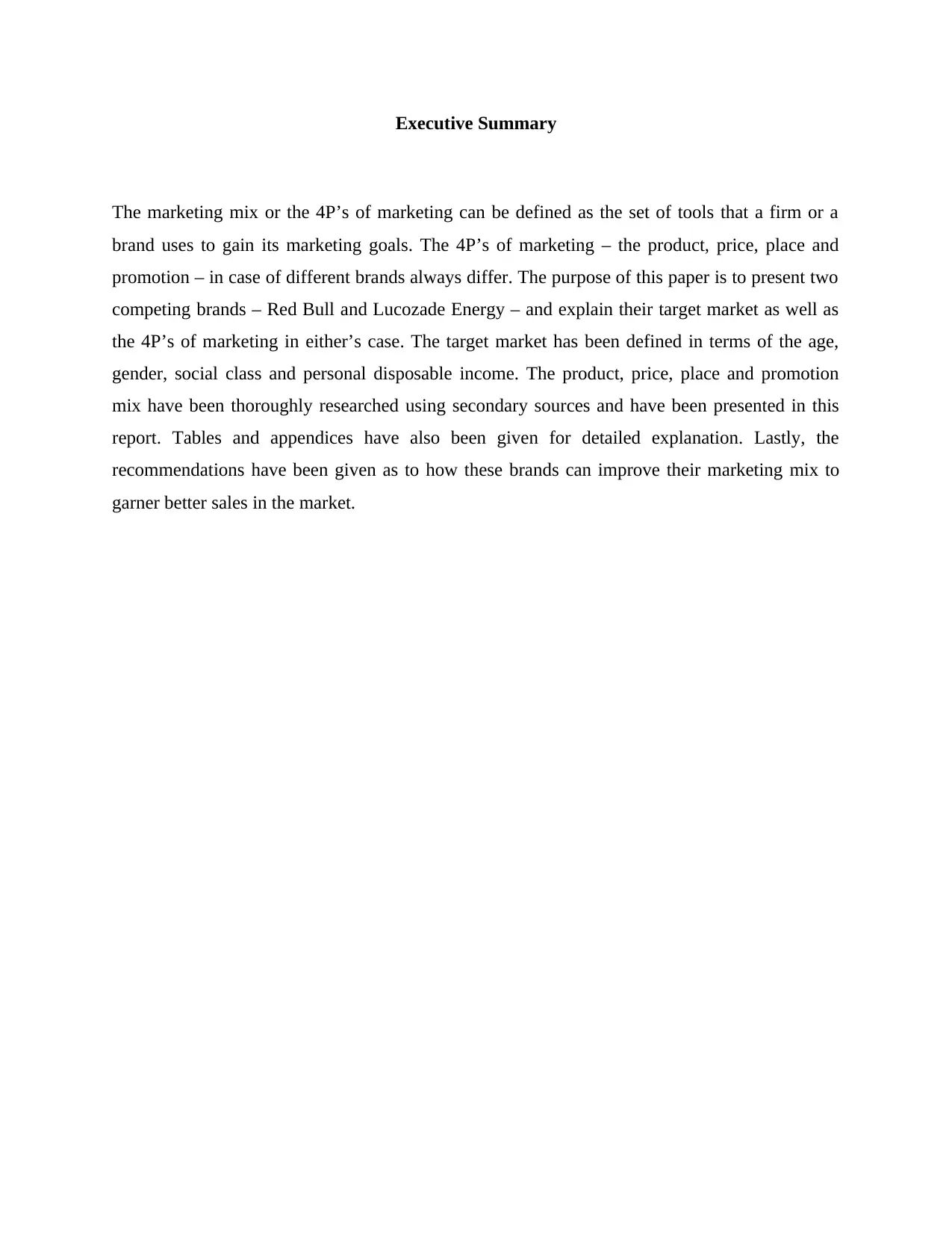
Executive Summary
The marketing mix or the 4P’s of marketing can be defined as the set of tools that a firm or a
brand uses to gain its marketing goals. The 4P’s of marketing – the product, price, place and
promotion – in case of different brands always differ. The purpose of this paper is to present two
competing brands – Red Bull and Lucozade Energy – and explain their target market as well as
the 4P’s of marketing in either’s case. The target market has been defined in terms of the age,
gender, social class and personal disposable income. The product, price, place and promotion
mix have been thoroughly researched using secondary sources and have been presented in this
report. Tables and appendices have also been given for detailed explanation. Lastly, the
recommendations have been given as to how these brands can improve their marketing mix to
garner better sales in the market.
The marketing mix or the 4P’s of marketing can be defined as the set of tools that a firm or a
brand uses to gain its marketing goals. The 4P’s of marketing – the product, price, place and
promotion – in case of different brands always differ. The purpose of this paper is to present two
competing brands – Red Bull and Lucozade Energy – and explain their target market as well as
the 4P’s of marketing in either’s case. The target market has been defined in terms of the age,
gender, social class and personal disposable income. The product, price, place and promotion
mix have been thoroughly researched using secondary sources and have been presented in this
report. Tables and appendices have also been given for detailed explanation. Lastly, the
recommendations have been given as to how these brands can improve their marketing mix to
garner better sales in the market.
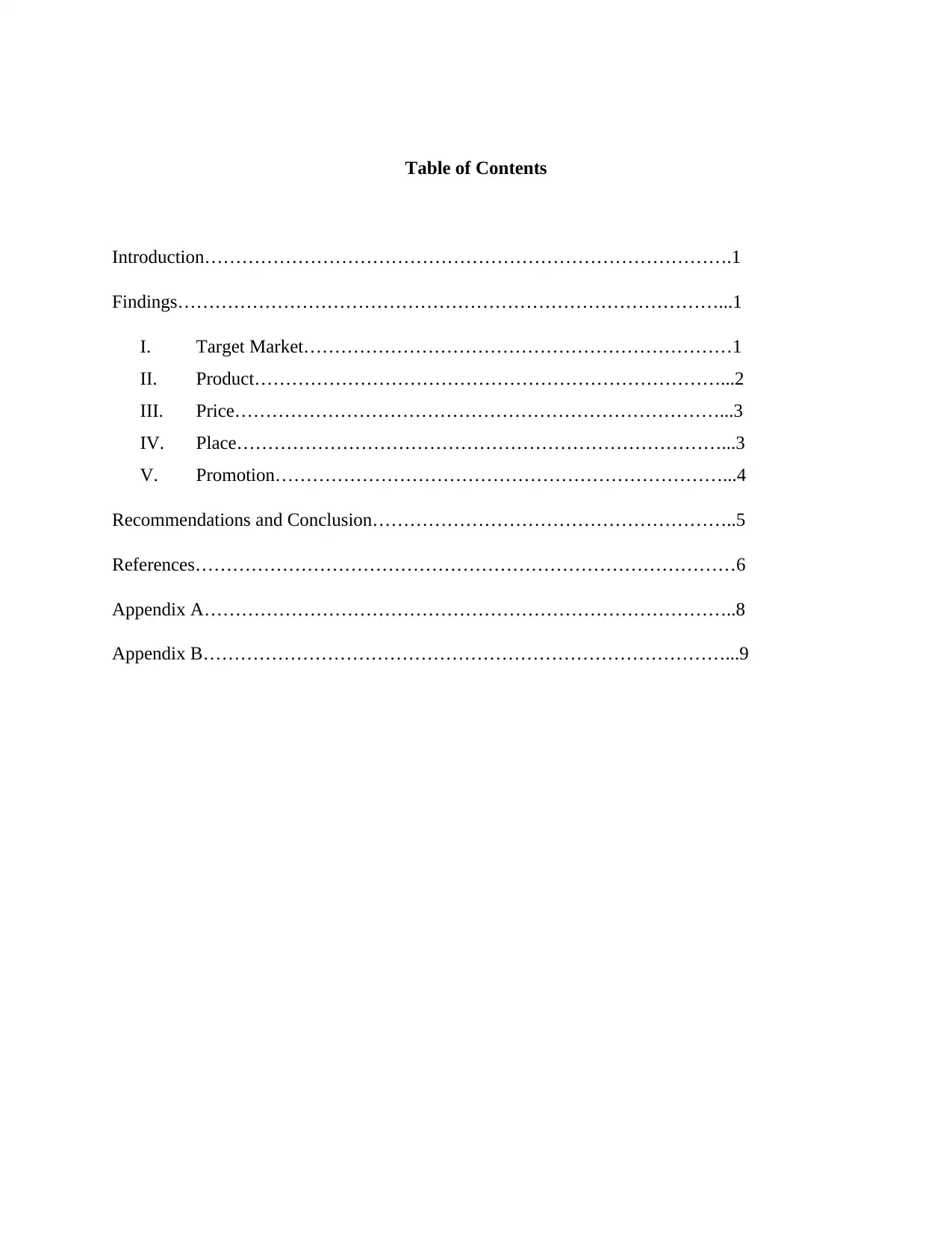
Table of Contents
Introduction………………………………………………………………………….1
Findings……………………………………………………………………………...1
I. Target Market……………………………………………………………1
II. Product…………………………………………………………………...2
III. Price……………………………………………………………………...3
IV. Place……………………………………………………………………...3
V. Promotion………………………………………………………………...4
Recommendations and Conclusion…………………………………………………..5
References……………………………………………………………………………6
Appendix A…………………………………………………………………………..8
Appendix B…………………………………………………………………………...9
Introduction………………………………………………………………………….1
Findings……………………………………………………………………………...1
I. Target Market……………………………………………………………1
II. Product…………………………………………………………………...2
III. Price……………………………………………………………………...3
IV. Place……………………………………………………………………...3
V. Promotion………………………………………………………………...4
Recommendations and Conclusion…………………………………………………..5
References……………………………………………………………………………6
Appendix A…………………………………………………………………………..8
Appendix B…………………………………………………………………………...9
⊘ This is a preview!⊘
Do you want full access?
Subscribe today to unlock all pages.

Trusted by 1+ million students worldwide

Paraphrase This Document
Need a fresh take? Get an instant paraphrase of this document with our AI Paraphraser

Introduction
The purpose of this report is to compare and analyze the 4P’s of marketing in the chosen brands.
The brands that are being compared here are Lucozade Energy and Red Bull. Lucozade Energy
is an energy drink manufactured by a Japanese company Suntory and promoted as sports drink.
Red Bull is an energy drink which is sold by Red Bull Inc. an Austrian Company created in
1987. It currently has the highest share of any energy drink in the world. The target market of the
brands have been discussed below, with special focus on age groups, gender, social class of the
customers and their personal disposable income. Then the 4P’s of marketing – product, price,
place and promotion – have been explained. Then the recommendations have been discussed so
as to determine ways in which these 4P’s of marketing can be improved.
Findings
On the basis of research done, the findings have been reported in the given section. The purpose
of these findings is to present a comparative analysis between the two products.
I. Target Market
It can be defined as the specific group of customers, based on their characteristic
features, which a company aims towards for the purpose of selling their products
(Lilyquist, 2018). From the research conducted, it is apparent that Red Bull is the
preferred drink. In the comparative analysis of Lucozade Energy Drink and Red Bull,
the target profile can be summarized as given below:
1. Age: The age of the customers towards which Lucozade Energy is marketed is 16
and Above (McCahill, 2018). Similarly, Red Bull is also focused towards children
over the age of 16 or 18.
2. Gender: Research has shown that while Red Bull is preferred by males only,
Lucozade Energy is preferred by men and women both (See Appendix A).
3. Personal Disposable Income: According to survey by Mintel Group (2016), the
price of Lucozade is “too expensive” and therefore, Red Bull is preferred by
people with low personal disposable income (“Lucozade SWOT and PEST
Analysis”, 2017).
4. Social Class: High class people general prefer Red Bull and those from lower
class buy Lucozade Energy (“Lucozade SWOT and PEST Analysis”, n.d.).
1
The purpose of this report is to compare and analyze the 4P’s of marketing in the chosen brands.
The brands that are being compared here are Lucozade Energy and Red Bull. Lucozade Energy
is an energy drink manufactured by a Japanese company Suntory and promoted as sports drink.
Red Bull is an energy drink which is sold by Red Bull Inc. an Austrian Company created in
1987. It currently has the highest share of any energy drink in the world. The target market of the
brands have been discussed below, with special focus on age groups, gender, social class of the
customers and their personal disposable income. Then the 4P’s of marketing – product, price,
place and promotion – have been explained. Then the recommendations have been discussed so
as to determine ways in which these 4P’s of marketing can be improved.
Findings
On the basis of research done, the findings have been reported in the given section. The purpose
of these findings is to present a comparative analysis between the two products.
I. Target Market
It can be defined as the specific group of customers, based on their characteristic
features, which a company aims towards for the purpose of selling their products
(Lilyquist, 2018). From the research conducted, it is apparent that Red Bull is the
preferred drink. In the comparative analysis of Lucozade Energy Drink and Red Bull,
the target profile can be summarized as given below:
1. Age: The age of the customers towards which Lucozade Energy is marketed is 16
and Above (McCahill, 2018). Similarly, Red Bull is also focused towards children
over the age of 16 or 18.
2. Gender: Research has shown that while Red Bull is preferred by males only,
Lucozade Energy is preferred by men and women both (See Appendix A).
3. Personal Disposable Income: According to survey by Mintel Group (2016), the
price of Lucozade is “too expensive” and therefore, Red Bull is preferred by
people with low personal disposable income (“Lucozade SWOT and PEST
Analysis”, 2017).
4. Social Class: High class people general prefer Red Bull and those from lower
class buy Lucozade Energy (“Lucozade SWOT and PEST Analysis”, n.d.).
1
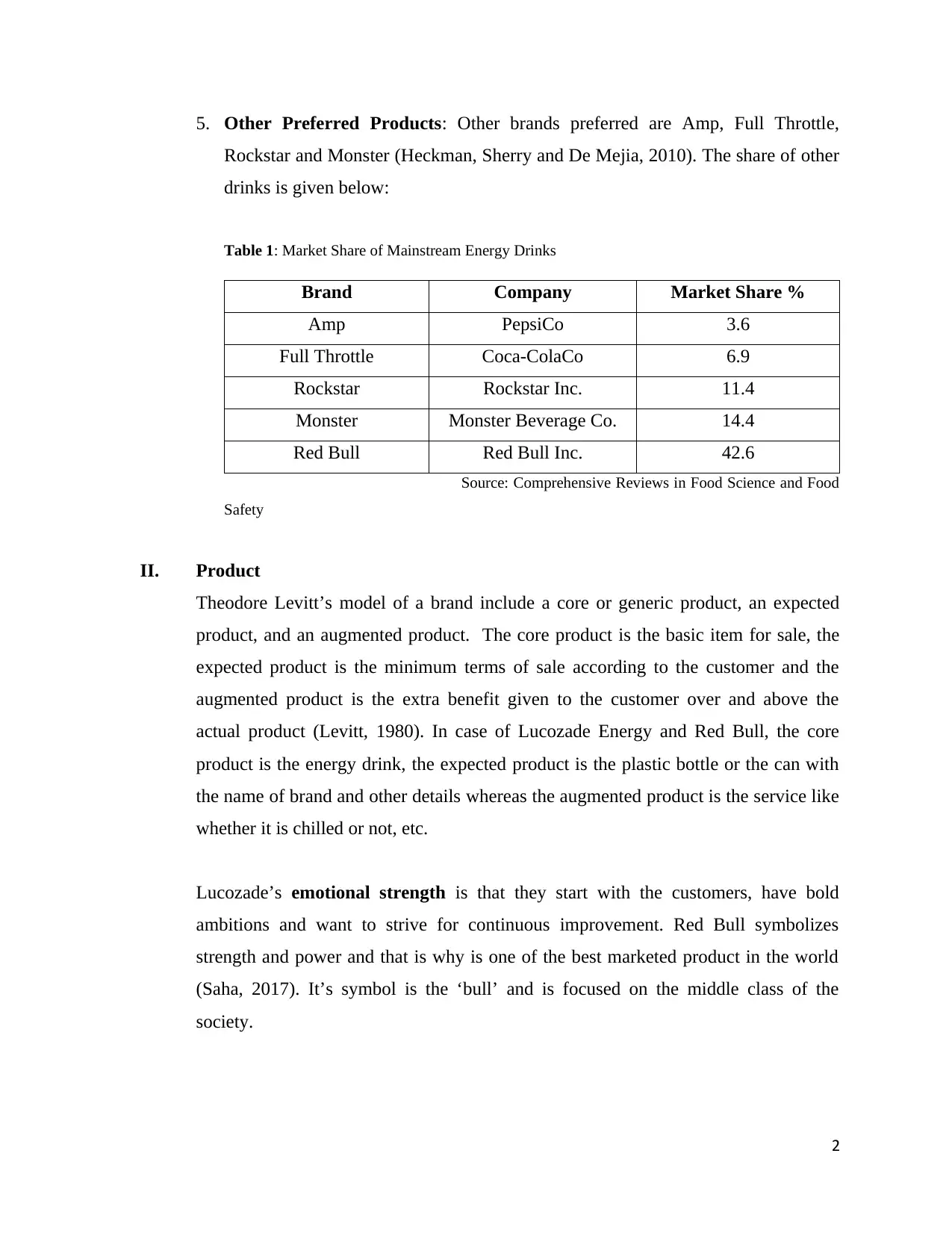
5. Other Preferred Products: Other brands preferred are Amp, Full Throttle,
Rockstar and Monster (Heckman, Sherry and De Mejia, 2010). The share of other
drinks is given below:
Table 1: Market Share of Mainstream Energy Drinks
Brand Company Market Share %
Amp PepsiCo 3.6
Full Throttle Coca-ColaCo 6.9
Rockstar Rockstar Inc. 11.4
Monster Monster Beverage Co. 14.4
Red Bull Red Bull Inc. 42.6
Source: Comprehensive Reviews in Food Science and Food
Safety
II. Product
Theodore Levitt’s model of a brand include a core or generic product, an expected
product, and an augmented product. The core product is the basic item for sale, the
expected product is the minimum terms of sale according to the customer and the
augmented product is the extra benefit given to the customer over and above the
actual product (Levitt, 1980). In case of Lucozade Energy and Red Bull, the core
product is the energy drink, the expected product is the plastic bottle or the can with
the name of brand and other details whereas the augmented product is the service like
whether it is chilled or not, etc.
Lucozade’s emotional strength is that they start with the customers, have bold
ambitions and want to strive for continuous improvement. Red Bull symbolizes
strength and power and that is why is one of the best marketed product in the world
(Saha, 2017). It’s symbol is the ‘bull’ and is focused on the middle class of the
society.
2
Rockstar and Monster (Heckman, Sherry and De Mejia, 2010). The share of other
drinks is given below:
Table 1: Market Share of Mainstream Energy Drinks
Brand Company Market Share %
Amp PepsiCo 3.6
Full Throttle Coca-ColaCo 6.9
Rockstar Rockstar Inc. 11.4
Monster Monster Beverage Co. 14.4
Red Bull Red Bull Inc. 42.6
Source: Comprehensive Reviews in Food Science and Food
Safety
II. Product
Theodore Levitt’s model of a brand include a core or generic product, an expected
product, and an augmented product. The core product is the basic item for sale, the
expected product is the minimum terms of sale according to the customer and the
augmented product is the extra benefit given to the customer over and above the
actual product (Levitt, 1980). In case of Lucozade Energy and Red Bull, the core
product is the energy drink, the expected product is the plastic bottle or the can with
the name of brand and other details whereas the augmented product is the service like
whether it is chilled or not, etc.
Lucozade’s emotional strength is that they start with the customers, have bold
ambitions and want to strive for continuous improvement. Red Bull symbolizes
strength and power and that is why is one of the best marketed product in the world
(Saha, 2017). It’s symbol is the ‘bull’ and is focused on the middle class of the
society.
2
⊘ This is a preview!⊘
Do you want full access?
Subscribe today to unlock all pages.

Trusted by 1+ million students worldwide
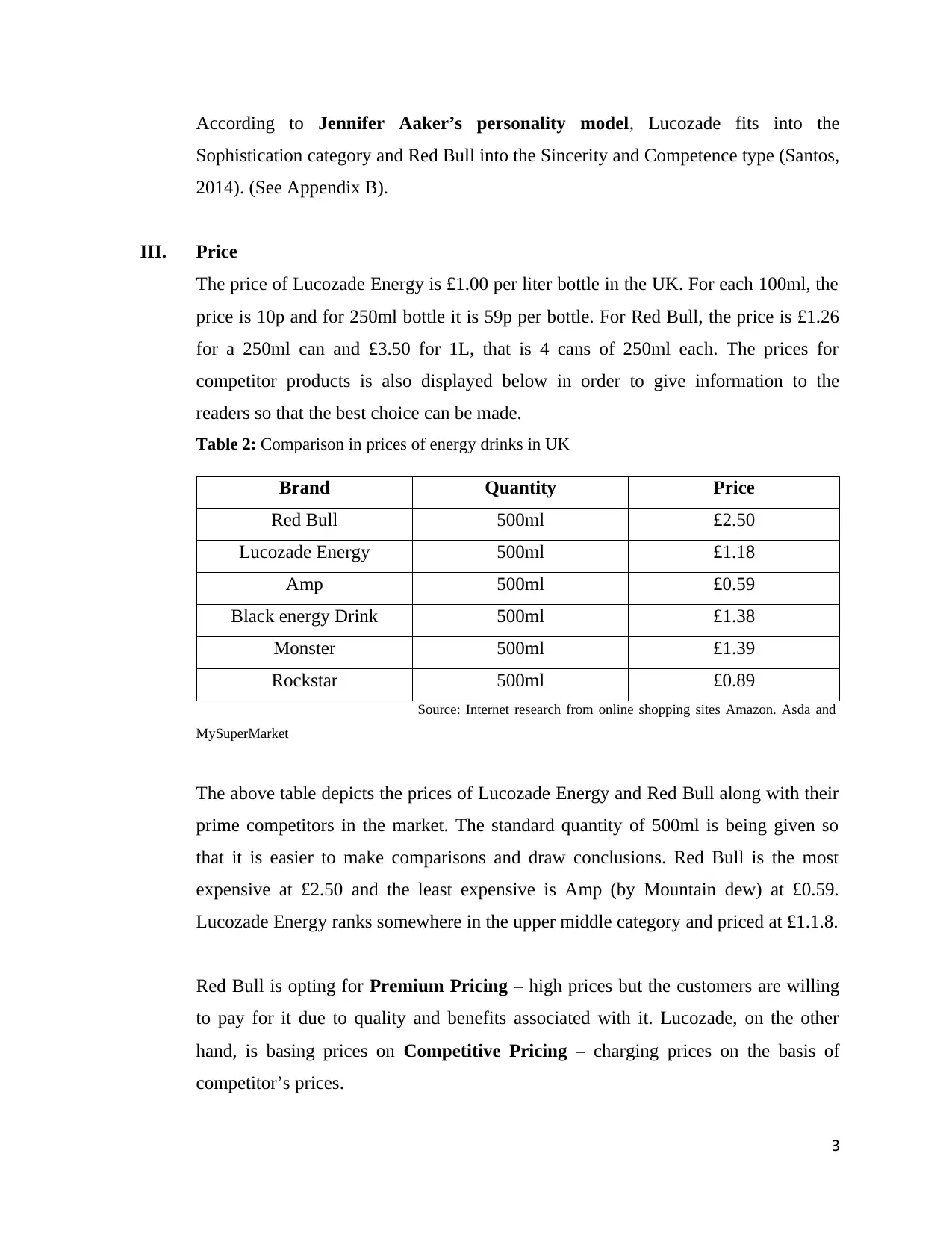
According to Jennifer Aaker’s personality model, Lucozade fits into the
Sophistication category and Red Bull into the Sincerity and Competence type (Santos,
2014). (See Appendix B).
III. Price
The price of Lucozade Energy is £1.00 per liter bottle in the UK. For each 100ml, the
price is 10p and for 250ml bottle it is 59p per bottle. For Red Bull, the price is £1.26
for a 250ml can and £3.50 for 1L, that is 4 cans of 250ml each. The prices for
competitor products is also displayed below in order to give information to the
readers so that the best choice can be made.
Table 2: Comparison in prices of energy drinks in UK
Brand Quantity Price
Red Bull 500ml £2.50
Lucozade Energy 500ml £1.18
Amp 500ml £0.59
Black energy Drink 500ml £1.38
Monster 500ml £1.39
Rockstar 500ml £0.89
Source: Internet research from online shopping sites Amazon. Asda and
MySuperMarket
The above table depicts the prices of Lucozade Energy and Red Bull along with their
prime competitors in the market. The standard quantity of 500ml is being given so
that it is easier to make comparisons and draw conclusions. Red Bull is the most
expensive at £2.50 and the least expensive is Amp (by Mountain dew) at £0.59.
Lucozade Energy ranks somewhere in the upper middle category and priced at £1.1.8.
Red Bull is opting for Premium Pricing – high prices but the customers are willing
to pay for it due to quality and benefits associated with it. Lucozade, on the other
hand, is basing prices on Competitive Pricing – charging prices on the basis of
competitor’s prices.
3
Sophistication category and Red Bull into the Sincerity and Competence type (Santos,
2014). (See Appendix B).
III. Price
The price of Lucozade Energy is £1.00 per liter bottle in the UK. For each 100ml, the
price is 10p and for 250ml bottle it is 59p per bottle. For Red Bull, the price is £1.26
for a 250ml can and £3.50 for 1L, that is 4 cans of 250ml each. The prices for
competitor products is also displayed below in order to give information to the
readers so that the best choice can be made.
Table 2: Comparison in prices of energy drinks in UK
Brand Quantity Price
Red Bull 500ml £2.50
Lucozade Energy 500ml £1.18
Amp 500ml £0.59
Black energy Drink 500ml £1.38
Monster 500ml £1.39
Rockstar 500ml £0.89
Source: Internet research from online shopping sites Amazon. Asda and
MySuperMarket
The above table depicts the prices of Lucozade Energy and Red Bull along with their
prime competitors in the market. The standard quantity of 500ml is being given so
that it is easier to make comparisons and draw conclusions. Red Bull is the most
expensive at £2.50 and the least expensive is Amp (by Mountain dew) at £0.59.
Lucozade Energy ranks somewhere in the upper middle category and priced at £1.1.8.
Red Bull is opting for Premium Pricing – high prices but the customers are willing
to pay for it due to quality and benefits associated with it. Lucozade, on the other
hand, is basing prices on Competitive Pricing – charging prices on the basis of
competitor’s prices.
3
Paraphrase This Document
Need a fresh take? Get an instant paraphrase of this document with our AI Paraphraser
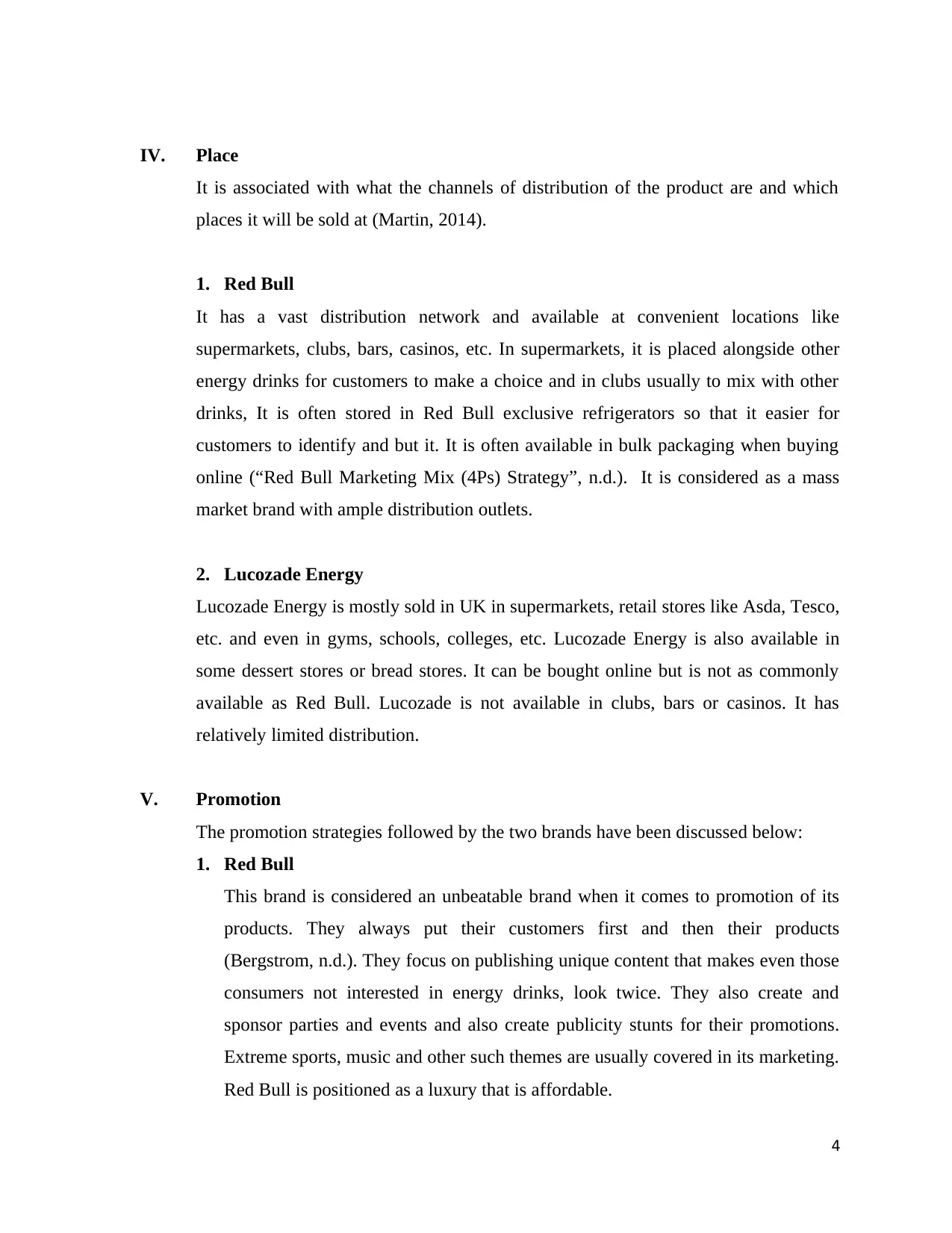
IV. Place
It is associated with what the channels of distribution of the product are and which
places it will be sold at (Martin, 2014).
1. Red Bull
It has a vast distribution network and available at convenient locations like
supermarkets, clubs, bars, casinos, etc. In supermarkets, it is placed alongside other
energy drinks for customers to make a choice and in clubs usually to mix with other
drinks, It is often stored in Red Bull exclusive refrigerators so that it easier for
customers to identify and but it. It is often available in bulk packaging when buying
online (“Red Bull Marketing Mix (4Ps) Strategy”, n.d.). It is considered as a mass
market brand with ample distribution outlets.
2. Lucozade Energy
Lucozade Energy is mostly sold in UK in supermarkets, retail stores like Asda, Tesco,
etc. and even in gyms, schools, colleges, etc. Lucozade Energy is also available in
some dessert stores or bread stores. It can be bought online but is not as commonly
available as Red Bull. Lucozade is not available in clubs, bars or casinos. It has
relatively limited distribution.
V. Promotion
The promotion strategies followed by the two brands have been discussed below:
1. Red Bull
This brand is considered an unbeatable brand when it comes to promotion of its
products. They always put their customers first and then their products
(Bergstrom, n.d.). They focus on publishing unique content that makes even those
consumers not interested in energy drinks, look twice. They also create and
sponsor parties and events and also create publicity stunts for their promotions.
Extreme sports, music and other such themes are usually covered in its marketing.
Red Bull is positioned as a luxury that is affordable.
4
It is associated with what the channels of distribution of the product are and which
places it will be sold at (Martin, 2014).
1. Red Bull
It has a vast distribution network and available at convenient locations like
supermarkets, clubs, bars, casinos, etc. In supermarkets, it is placed alongside other
energy drinks for customers to make a choice and in clubs usually to mix with other
drinks, It is often stored in Red Bull exclusive refrigerators so that it easier for
customers to identify and but it. It is often available in bulk packaging when buying
online (“Red Bull Marketing Mix (4Ps) Strategy”, n.d.). It is considered as a mass
market brand with ample distribution outlets.
2. Lucozade Energy
Lucozade Energy is mostly sold in UK in supermarkets, retail stores like Asda, Tesco,
etc. and even in gyms, schools, colleges, etc. Lucozade Energy is also available in
some dessert stores or bread stores. It can be bought online but is not as commonly
available as Red Bull. Lucozade is not available in clubs, bars or casinos. It has
relatively limited distribution.
V. Promotion
The promotion strategies followed by the two brands have been discussed below:
1. Red Bull
This brand is considered an unbeatable brand when it comes to promotion of its
products. They always put their customers first and then their products
(Bergstrom, n.d.). They focus on publishing unique content that makes even those
consumers not interested in energy drinks, look twice. They also create and
sponsor parties and events and also create publicity stunts for their promotions.
Extreme sports, music and other such themes are usually covered in its marketing.
Red Bull is positioned as a luxury that is affordable.
4
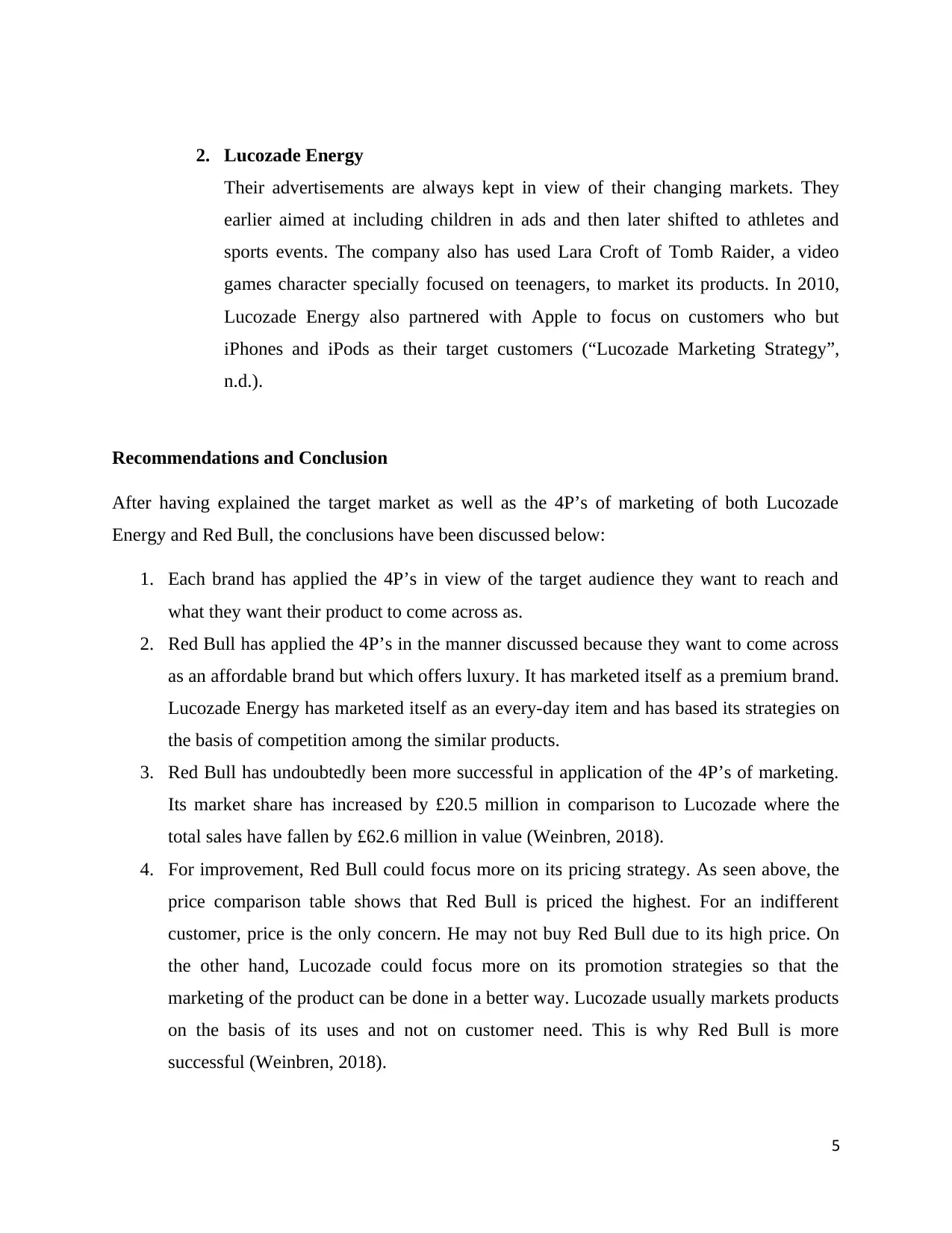
2. Lucozade Energy
Their advertisements are always kept in view of their changing markets. They
earlier aimed at including children in ads and then later shifted to athletes and
sports events. The company also has used Lara Croft of Tomb Raider, a video
games character specially focused on teenagers, to market its products. In 2010,
Lucozade Energy also partnered with Apple to focus on customers who but
iPhones and iPods as their target customers (“Lucozade Marketing Strategy”,
n.d.).
Recommendations and Conclusion
After having explained the target market as well as the 4P’s of marketing of both Lucozade
Energy and Red Bull, the conclusions have been discussed below:
1. Each brand has applied the 4P’s in view of the target audience they want to reach and
what they want their product to come across as.
2. Red Bull has applied the 4P’s in the manner discussed because they want to come across
as an affordable brand but which offers luxury. It has marketed itself as a premium brand.
Lucozade Energy has marketed itself as an every-day item and has based its strategies on
the basis of competition among the similar products.
3. Red Bull has undoubtedly been more successful in application of the 4P’s of marketing.
Its market share has increased by £20.5 million in comparison to Lucozade where the
total sales have fallen by £62.6 million in value (Weinbren, 2018).
4. For improvement, Red Bull could focus more on its pricing strategy. As seen above, the
price comparison table shows that Red Bull is priced the highest. For an indifferent
customer, price is the only concern. He may not buy Red Bull due to its high price. On
the other hand, Lucozade could focus more on its promotion strategies so that the
marketing of the product can be done in a better way. Lucozade usually markets products
on the basis of its uses and not on customer need. This is why Red Bull is more
successful (Weinbren, 2018).
5
Their advertisements are always kept in view of their changing markets. They
earlier aimed at including children in ads and then later shifted to athletes and
sports events. The company also has used Lara Croft of Tomb Raider, a video
games character specially focused on teenagers, to market its products. In 2010,
Lucozade Energy also partnered with Apple to focus on customers who but
iPhones and iPods as their target customers (“Lucozade Marketing Strategy”,
n.d.).
Recommendations and Conclusion
After having explained the target market as well as the 4P’s of marketing of both Lucozade
Energy and Red Bull, the conclusions have been discussed below:
1. Each brand has applied the 4P’s in view of the target audience they want to reach and
what they want their product to come across as.
2. Red Bull has applied the 4P’s in the manner discussed because they want to come across
as an affordable brand but which offers luxury. It has marketed itself as a premium brand.
Lucozade Energy has marketed itself as an every-day item and has based its strategies on
the basis of competition among the similar products.
3. Red Bull has undoubtedly been more successful in application of the 4P’s of marketing.
Its market share has increased by £20.5 million in comparison to Lucozade where the
total sales have fallen by £62.6 million in value (Weinbren, 2018).
4. For improvement, Red Bull could focus more on its pricing strategy. As seen above, the
price comparison table shows that Red Bull is priced the highest. For an indifferent
customer, price is the only concern. He may not buy Red Bull due to its high price. On
the other hand, Lucozade could focus more on its promotion strategies so that the
marketing of the product can be done in a better way. Lucozade usually markets products
on the basis of its uses and not on customer need. This is why Red Bull is more
successful (Weinbren, 2018).
5
⊘ This is a preview!⊘
Do you want full access?
Subscribe today to unlock all pages.

Trusted by 1+ million students worldwide
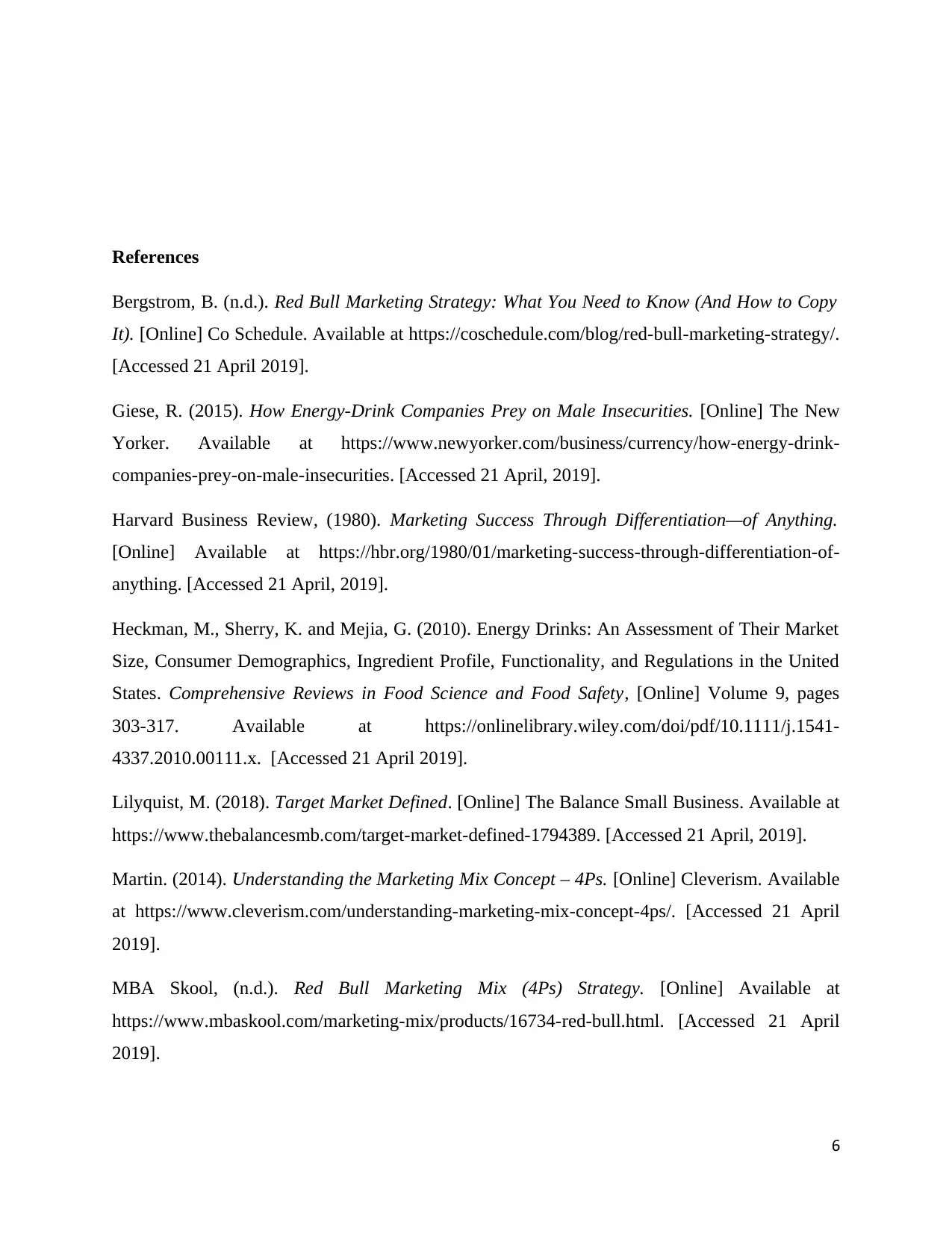
References
Bergstrom, B. (n.d.). Red Bull Marketing Strategy: What You Need to Know (And How to Copy
It). [Online] Co Schedule. Available at https://coschedule.com/blog/red-bull-marketing-strategy/.
[Accessed 21 April 2019].
Giese, R. (2015). How Energy-Drink Companies Prey on Male Insecurities. [Online] The New
Yorker. Available at https://www.newyorker.com/business/currency/how-energy-drink-
companies-prey-on-male-insecurities. [Accessed 21 April, 2019].
Harvard Business Review, (1980). Marketing Success Through Differentiation—of Anything.
[Online] Available at https://hbr.org/1980/01/marketing-success-through-differentiation-of-
anything. [Accessed 21 April, 2019].
Heckman, M., Sherry, K. and Mejia, G. (2010). Energy Drinks: An Assessment of Their Market
Size, Consumer Demographics, Ingredient Profile, Functionality, and Regulations in the United
States. Comprehensive Reviews in Food Science and Food Safety, [Online] Volume 9, pages
303-317. Available at https://onlinelibrary.wiley.com/doi/pdf/10.1111/j.1541-
4337.2010.00111.x. [Accessed 21 April 2019].
Lilyquist, M. (2018). Target Market Defined. [Online] The Balance Small Business. Available at
https://www.thebalancesmb.com/target-market-defined-1794389. [Accessed 21 April, 2019].
Martin. (2014). Understanding the Marketing Mix Concept – 4Ps. [Online] Cleverism. Available
at https://www.cleverism.com/understanding-marketing-mix-concept-4ps/. [Accessed 21 April
2019].
MBA Skool, (n.d.). Red Bull Marketing Mix (4Ps) Strategy. [Online] Available at
https://www.mbaskool.com/marketing-mix/products/16734-red-bull.html. [Accessed 21 April
2019].
6
Bergstrom, B. (n.d.). Red Bull Marketing Strategy: What You Need to Know (And How to Copy
It). [Online] Co Schedule. Available at https://coschedule.com/blog/red-bull-marketing-strategy/.
[Accessed 21 April 2019].
Giese, R. (2015). How Energy-Drink Companies Prey on Male Insecurities. [Online] The New
Yorker. Available at https://www.newyorker.com/business/currency/how-energy-drink-
companies-prey-on-male-insecurities. [Accessed 21 April, 2019].
Harvard Business Review, (1980). Marketing Success Through Differentiation—of Anything.
[Online] Available at https://hbr.org/1980/01/marketing-success-through-differentiation-of-
anything. [Accessed 21 April, 2019].
Heckman, M., Sherry, K. and Mejia, G. (2010). Energy Drinks: An Assessment of Their Market
Size, Consumer Demographics, Ingredient Profile, Functionality, and Regulations in the United
States. Comprehensive Reviews in Food Science and Food Safety, [Online] Volume 9, pages
303-317. Available at https://onlinelibrary.wiley.com/doi/pdf/10.1111/j.1541-
4337.2010.00111.x. [Accessed 21 April 2019].
Lilyquist, M. (2018). Target Market Defined. [Online] The Balance Small Business. Available at
https://www.thebalancesmb.com/target-market-defined-1794389. [Accessed 21 April, 2019].
Martin. (2014). Understanding the Marketing Mix Concept – 4Ps. [Online] Cleverism. Available
at https://www.cleverism.com/understanding-marketing-mix-concept-4ps/. [Accessed 21 April
2019].
MBA Skool, (n.d.). Red Bull Marketing Mix (4Ps) Strategy. [Online] Available at
https://www.mbaskool.com/marketing-mix/products/16734-red-bull.html. [Accessed 21 April
2019].
6
Paraphrase This Document
Need a fresh take? Get an instant paraphrase of this document with our AI Paraphraser
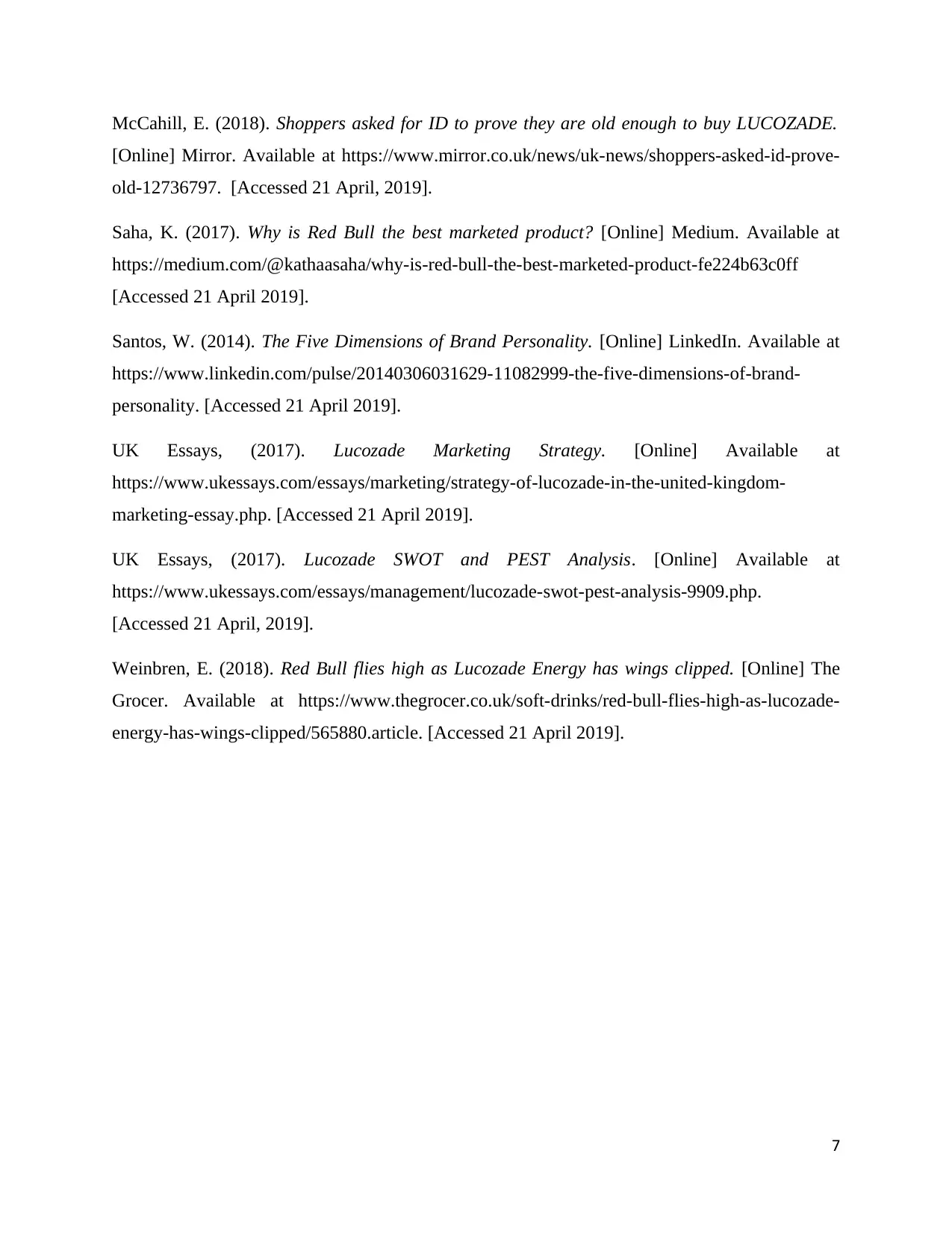
McCahill, E. (2018). Shoppers asked for ID to prove they are old enough to buy LUCOZADE.
[Online] Mirror. Available at https://www.mirror.co.uk/news/uk-news/shoppers-asked-id-prove-
old-12736797. [Accessed 21 April, 2019].
Saha, K. (2017). Why is Red Bull the best marketed product? [Online] Medium. Available at
https://medium.com/@kathaasaha/why-is-red-bull-the-best-marketed-product-fe224b63c0ff
[Accessed 21 April 2019].
Santos, W. (2014). The Five Dimensions of Brand Personality. [Online] LinkedIn. Available at
https://www.linkedin.com/pulse/20140306031629-11082999-the-five-dimensions-of-brand-
personality. [Accessed 21 April 2019].
UK Essays, (2017). Lucozade Marketing Strategy. [Online] Available at
https://www.ukessays.com/essays/marketing/strategy-of-lucozade-in-the-united-kingdom-
marketing-essay.php. [Accessed 21 April 2019].
UK Essays, (2017). Lucozade SWOT and PEST Analysis. [Online] Available at
https://www.ukessays.com/essays/management/lucozade-swot-pest-analysis-9909.php.
[Accessed 21 April, 2019].
Weinbren, E. (2018). Red Bull flies high as Lucozade Energy has wings clipped. [Online] The
Grocer. Available at https://www.thegrocer.co.uk/soft-drinks/red-bull-flies-high-as-lucozade-
energy-has-wings-clipped/565880.article. [Accessed 21 April 2019].
7
[Online] Mirror. Available at https://www.mirror.co.uk/news/uk-news/shoppers-asked-id-prove-
old-12736797. [Accessed 21 April, 2019].
Saha, K. (2017). Why is Red Bull the best marketed product? [Online] Medium. Available at
https://medium.com/@kathaasaha/why-is-red-bull-the-best-marketed-product-fe224b63c0ff
[Accessed 21 April 2019].
Santos, W. (2014). The Five Dimensions of Brand Personality. [Online] LinkedIn. Available at
https://www.linkedin.com/pulse/20140306031629-11082999-the-five-dimensions-of-brand-
personality. [Accessed 21 April 2019].
UK Essays, (2017). Lucozade Marketing Strategy. [Online] Available at
https://www.ukessays.com/essays/marketing/strategy-of-lucozade-in-the-united-kingdom-
marketing-essay.php. [Accessed 21 April 2019].
UK Essays, (2017). Lucozade SWOT and PEST Analysis. [Online] Available at
https://www.ukessays.com/essays/management/lucozade-swot-pest-analysis-9909.php.
[Accessed 21 April, 2019].
Weinbren, E. (2018). Red Bull flies high as Lucozade Energy has wings clipped. [Online] The
Grocer. Available at https://www.thegrocer.co.uk/soft-drinks/red-bull-flies-high-as-lucozade-
energy-has-wings-clipped/565880.article. [Accessed 21 April 2019].
7
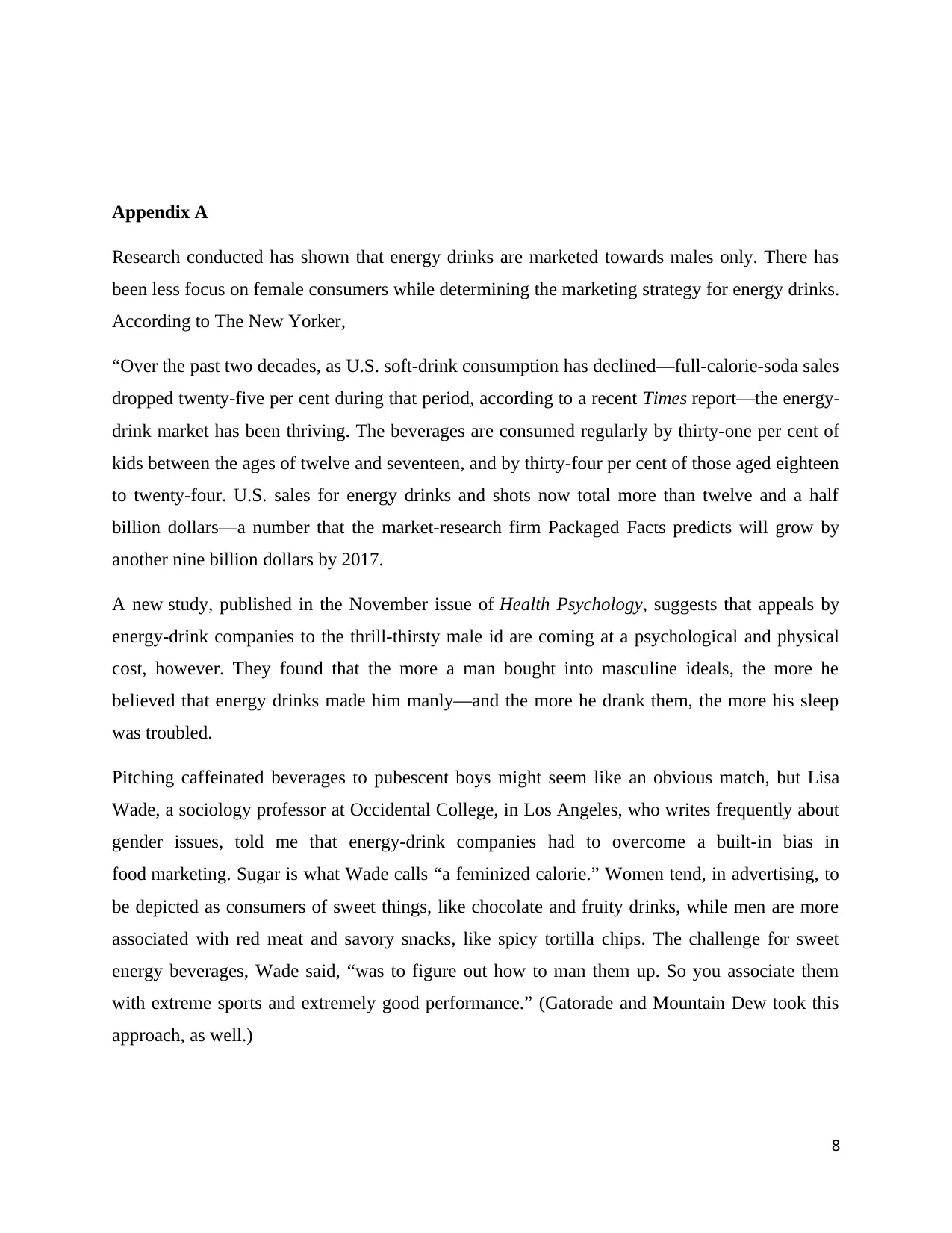
Appendix A
Research conducted has shown that energy drinks are marketed towards males only. There has
been less focus on female consumers while determining the marketing strategy for energy drinks.
According to The New Yorker,
“Over the past two decades, as U.S. soft-drink consumption has declined—full-calorie-soda sales
dropped twenty-five per cent during that period, according to a recent Times report—the energy-
drink market has been thriving. The beverages are consumed regularly by thirty-one per cent of
kids between the ages of twelve and seventeen, and by thirty-four per cent of those aged eighteen
to twenty-four. U.S. sales for energy drinks and shots now total more than twelve and a half
billion dollars—a number that the market-research firm Packaged Facts predicts will grow by
another nine billion dollars by 2017.
A new study, published in the November issue of Health Psychology, suggests that appeals by
energy-drink companies to the thrill-thirsty male id are coming at a psychological and physical
cost, however. They found that the more a man bought into masculine ideals, the more he
believed that energy drinks made him manly—and the more he drank them, the more his sleep
was troubled.
Pitching caffeinated beverages to pubescent boys might seem like an obvious match, but Lisa
Wade, a sociology professor at Occidental College, in Los Angeles, who writes frequently about
gender issues, told me that energy-drink companies had to overcome a built-in bias in
food marketing. Sugar is what Wade calls “a feminized calorie.” Women tend, in advertising, to
be depicted as consumers of sweet things, like chocolate and fruity drinks, while men are more
associated with red meat and savory snacks, like spicy tortilla chips. The challenge for sweet
energy beverages, Wade said, “was to figure out how to man them up. So you associate them
with extreme sports and extremely good performance.” (Gatorade and Mountain Dew took this
approach, as well.)
8
Research conducted has shown that energy drinks are marketed towards males only. There has
been less focus on female consumers while determining the marketing strategy for energy drinks.
According to The New Yorker,
“Over the past two decades, as U.S. soft-drink consumption has declined—full-calorie-soda sales
dropped twenty-five per cent during that period, according to a recent Times report—the energy-
drink market has been thriving. The beverages are consumed regularly by thirty-one per cent of
kids between the ages of twelve and seventeen, and by thirty-four per cent of those aged eighteen
to twenty-four. U.S. sales for energy drinks and shots now total more than twelve and a half
billion dollars—a number that the market-research firm Packaged Facts predicts will grow by
another nine billion dollars by 2017.
A new study, published in the November issue of Health Psychology, suggests that appeals by
energy-drink companies to the thrill-thirsty male id are coming at a psychological and physical
cost, however. They found that the more a man bought into masculine ideals, the more he
believed that energy drinks made him manly—and the more he drank them, the more his sleep
was troubled.
Pitching caffeinated beverages to pubescent boys might seem like an obvious match, but Lisa
Wade, a sociology professor at Occidental College, in Los Angeles, who writes frequently about
gender issues, told me that energy-drink companies had to overcome a built-in bias in
food marketing. Sugar is what Wade calls “a feminized calorie.” Women tend, in advertising, to
be depicted as consumers of sweet things, like chocolate and fruity drinks, while men are more
associated with red meat and savory snacks, like spicy tortilla chips. The challenge for sweet
energy beverages, Wade said, “was to figure out how to man them up. So you associate them
with extreme sports and extremely good performance.” (Gatorade and Mountain Dew took this
approach, as well.)
8
⊘ This is a preview!⊘
Do you want full access?
Subscribe today to unlock all pages.

Trusted by 1+ million students worldwide
1 out of 13
Related Documents
Your All-in-One AI-Powered Toolkit for Academic Success.
+13062052269
info@desklib.com
Available 24*7 on WhatsApp / Email
![[object Object]](/_next/static/media/star-bottom.7253800d.svg)
Unlock your academic potential
Copyright © 2020–2025 A2Z Services. All Rights Reserved. Developed and managed by ZUCOL.





